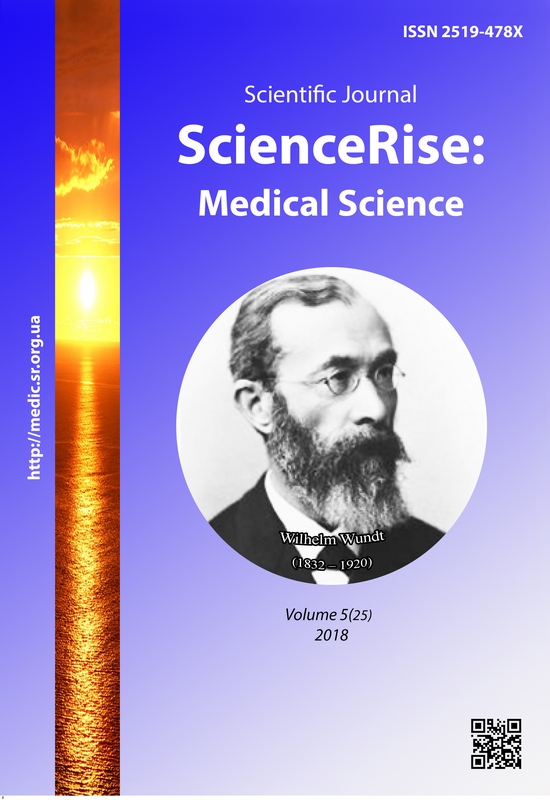The strategy of improving anesthesia in septoplasty by the use of new adjuvants
DOI:
https://doi.org/10.15587/2519-4798.2018.139729Keywords:
combined anesthesia, dexmedetomidine, paracetamol, ANI, septoplasty, hemodynamics, multimodal analgesia, hemostasisAbstract
The aim of the study was to find methods for optimizing perioperative analgesia, stabilizing hemodynamics, improving control of in
Materials and methods: The study included 53 patients, divided into 2 groups: primary (n=28) and control (n=25). In the main group, infusion of dexmedetomidine and intravenous form of paracetamol was carried out. The hemodynamic parameters, the general blood test, the coagulogram, the volume of blood loss, the duration of anesthesia and surgical intervention, the dose of anesthetics and analgesics, the pain level according to the VAS were investigated.
Results: In the "P + D" group mean arterial pressure, heart rate and systolic index during induction of anesthesia, intubation, surgical intervention and after awakening of patients are significantly lower than in the control (p<0,001). The level of ANI at all stages of observation is significantly higher in the group "P + D" (p<0,001). The level of hemoglobin, hematocrit and erythrocytes in the postoperative period is lower in the "K" group than in the "P + D" group (p<0,001). In the "P + D" group, the blood loss is significantly less than in the control group (p<0,001). In the "P + D" group, the duration of surgery and anesthesia, the dose of anesthetics and narcotic analgesics is significantly lower than in the control (p<0,001). In the "P + D" group, Duke bleeding time and Lee-White coagulation time (p<0,001) is significantly shorter. Responses of patients are higher in the "P + D" group. The quality of visualization of the operating field is better in the group "P + D" (p<0,001).
In the future, it is planned to conduct BIS studies to identify correlation with ANI and other indicators and compare ANI scores with such methods of objectifying the intraoperative level of pain as assessment of skin conductivity, determination of pupillary response, measurement of pulse wave amplitude and the like.
However, this study is limited in renal, hepatic insufficiency and unstable hemodynamics. ANI is not interpreted in the following situations: atrial fibrillation, absence of breathing, respiratory rate less than 9 per 1 minute, presence of a pacemaker, use of atropine, adrenaline.
The intravenous form of paracetamol and dexmedetomidine can be recommended for use in practical activities in nasal surgery to optimize anesthetic maintenance.
Conclusion: Combination of dexmedetomidine and paracetamol with septoplasty allows to provide a reliable analgesia in the perioperative period. The introduction of dexmedetomidine and paracetamol correlates with the stabilization of hemodynamics in the perioperative period. Infusion of dexmedetomidine and paracetamol helps to reduce intraoperative blood loss and improve the visualization of the operating field
References
- Ovechkin, A. M., Kobelyatskiy, Yu. Yu., Chumachenko, E. D., Shimanskiy, Yu. (2013). Novyie gorizontyi anesteziologii, intensivnoy terapii kriticheskih sostoyaniy i lecheniya boli. Meditsina neotlozhnyih sostoyaniy, 8 (55), 68–76.
- Dubrov, S. A., Kuchin, Yu. L. (2016). Osnovnyie printsipyi uskorennogo vosstanovleniya patsientov posle hirurgicheskih vmeshatelstv. Zdorov’ya Ukrayini, 1 (23), 3.
- Avakov, V. E., Sayipov, R. M., Isomov, T. M., Bozorov, G. M. (2016). Paratsetamol v posleoperatsionnoy analgezii. Travma, 17 (1), 28–32.
- Pavlenko, A. Yu., Beletskiy, A. V., Nikonov, V. V. (2012). Infulgan – bazovyiy komponent multimodalnoy analgezii. Meditsina neotlozhnyih sostoyaniy, 1 (40). Available at: http://www.mif-ua.com/archive/article/26893
- Kobelyatskiy, Yu. Yu. (2012). Rasshirenie vozmozhnostey perioperatsionnoy analgezii. Meditsina neotlozhnyih sostoyaniy, 2 (41). URL: http://www.mif-ua.com/archive/article/27404
- Gerresheim, G., Schwemmer, U. (2013). Dexmedetomidin. Der Anaesthesist, 62 (8), 661–674. doi: http://doi.org/10.1007/s00101-013-2206-6
- Kobelyatskiy, Yu. Yu., Mashin, A. M., Karas, R. K. (2013). Mesto deksmedetomidina v sovremennoy anesteziologii. Dnipropetrovsk, 22.
- Afonso, J., Reis, F. (2012). Dexmedetomidine: Current Role in Anesthesia and Intensive Care. Brazilian Journal of Anesthesiology, 62 (1), 118–133. doi: http://doi.org/10.1016/s0034-7094(12)70110-1
- Zarzar, A. S., Kim, E. V., Ataksanov, Sh. E., Maxmudov, M. A., Zabitova, Z. M. (1991). Ispolzovanie mikrokalkulyatorov dlya raschyota gemodinamicheskix parametrov levogo zheludochka. Anesteziologiya i reanimatologiya, 2, 2.
- Volkov, P. A., Churadze, B. T., Sevalkin, S. A., Volkova, Yu. N., Guryanov, V. A. (2015). Deksmedetomidin kak sostavlyayuschaya analgeticheskogo komponenta obschey anestezii pri laparoskopicheskih operatsiyah. Anesteziologiya i reanimtaologiya, 1, 4–8.
- Domoratskiy, A. E., Krylyuk, V. E., Sozanskiy, V. V., Rybak, K. A., Kryatchenko, E. B. (2016). Effektivnost i bezopasnost premedikatsii sovremennymi α-2agonistami v perioperatsionnom periode. Meditsina neotlozhnykh sostoyaniy, 3 (74), 117–120.
- Nichitaylo, M. E., Bulik, L. M. (2015). Infulgan – optimalnіy analgeticheskiy preparat dlya primeneniya v laparoskopicheskoy terapii. Klіnіchna khіrurgіya, 6, 9–10.
Downloads
Published
How to Cite
Issue
Section
License
Copyright (c) 2018 Aleksandr Ayvardgi, Yurij Kobelyatskyy

This work is licensed under a Creative Commons Attribution 4.0 International License.
Our journal abides by the Creative Commons CC BY copyright rights and permissions for open access journals.
Authors, who are published in this journal, agree to the following conditions:
1. The authors reserve the right to authorship of the work and pass the first publication right of this work to the journal under the terms of a Creative Commons CC BY, which allows others to freely distribute the published research with the obligatory reference to the authors of the original work and the first publication of the work in this journal.
2. The authors have the right to conclude separate supplement agreements that relate to non-exclusive work distribution in the form in which it has been published by the journal (for example, to upload the work to the online storage of the journal or publish it as part of a monograph), provided that the reference to the first publication of the work in this journal is included.









